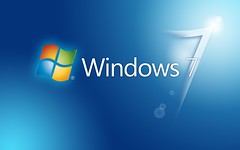Search This Blog
Creating Virtual Hard Drive in Windows 7
By Remote Computer Support on 1:01 AM
Filed Under: computers technology, software, windows 7, Windows 7 Virtual Hard Drive
With so many of files being piled up, there is always a need to have an extra hard disk. There is a wish to have an extra Hard Disk to store files, share, or set aside as an encrypted vault. Well, Windows 7 has this unique feature of creating Virtual Hard Disks. In this article we would be discussing the steps for creating virtual hard drives in Windows 7.
Create a Virtual Drive This process creates virtual disks in the .VHD format where the minimum size is 3MB. Follow the given below steps. Right-click on My Computer and select to Manage. Alternately you can type diskmgmt.msc into the Start search box and enter. The Computer Management screen opens click on Disk Management then Action and Create VHD. Browse to the directory you want the disk to reside, choose the size you want it to be, and select dynamic or a fixed.
If you want the disk to expand in size as you add files to it, then choose Dynamically expanding. Check Fixed size if you want a specific size and for it to stay that way. In Disk Management you will see the virtual drive listed as unallocated space. To begin using it you'll need to Right-click and select Initialize Disk. In the initialize disk box just keep MBR selected and hit OK. Create a Volume Now it is time to create a volume. Right-click the unallocated space and select New Simple Volume. Choose the amount of space you want to use for the volume. Assign it a drive letter that is not currently being used. Format the new volume as NTFS, FAT32, or FAT. Check if you want a quick format and file compression. The wizard is complete, click on Finish. If you have AutoPlay enabled it should pop up for you to open up your new virtual hard disk. It will be listed with the other disks in Disk Management.
Of course you will also see it listen under My Computer. This is a cool new feature that will let you use the disk as you would any type of real disk. You can encrypt it; share it out to other systems, store files to it. However you would use an extra disk connected to your system. This adds extra functionality and options to your current system. Quite often while creating drives, formatting system, partitioning hard disk land you up in big trouble. You lose files and folders owing to corrupt, damaged, formatted, deleted partitions. In such times, data recovery utilities to be an elixir. Professional data recovery utilities help in getting back all lost files and data. Data recovery utilities perfectly recover files and folders from deleted, formatted, reformatted and corrupt partitions.
Create a Virtual Drive This process creates virtual disks in the .VHD format where the minimum size is 3MB. Follow the given below steps. Right-click on My Computer and select to Manage. Alternately you can type diskmgmt.msc into the Start search box and enter. The Computer Management screen opens click on Disk Management then Action and Create VHD. Browse to the directory you want the disk to reside, choose the size you want it to be, and select dynamic or a fixed.
If you want the disk to expand in size as you add files to it, then choose Dynamically expanding. Check Fixed size if you want a specific size and for it to stay that way. In Disk Management you will see the virtual drive listed as unallocated space. To begin using it you'll need to Right-click and select Initialize Disk. In the initialize disk box just keep MBR selected and hit OK. Create a Volume Now it is time to create a volume. Right-click the unallocated space and select New Simple Volume. Choose the amount of space you want to use for the volume. Assign it a drive letter that is not currently being used. Format the new volume as NTFS, FAT32, or FAT. Check if you want a quick format and file compression. The wizard is complete, click on Finish. If you have AutoPlay enabled it should pop up for you to open up your new virtual hard disk. It will be listed with the other disks in Disk Management.
Of course you will also see it listen under My Computer. This is a cool new feature that will let you use the disk as you would any type of real disk. You can encrypt it; share it out to other systems, store files to it. However you would use an extra disk connected to your system. This adds extra functionality and options to your current system. Quite often while creating drives, formatting system, partitioning hard disk land you up in big trouble. You lose files and folders owing to corrupt, damaged, formatted, deleted partitions. In such times, data recovery utilities to be an elixir. Professional data recovery utilities help in getting back all lost files and data. Data recovery utilities perfectly recover files and folders from deleted, formatted, reformatted and corrupt partitions.
Subscribe to:
Post Comments (Atom)


0 comments for this post